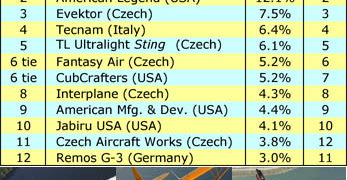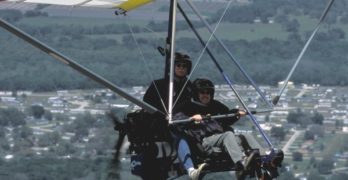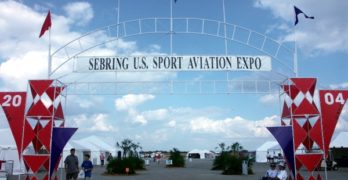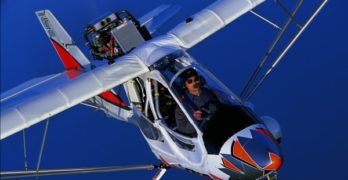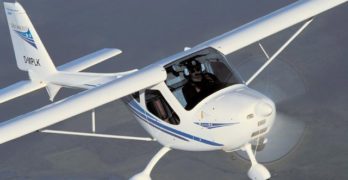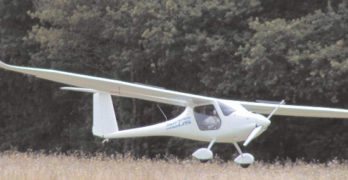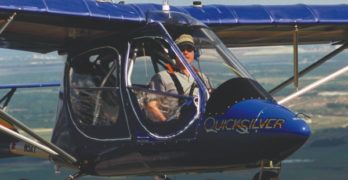In the month of July 2007 the LSA industry registered 71 more aircraft bringing the total to 904 fixed wing airplanes. That represents a spurt of 11% in one month and an even 60% growth in registered LSA since January 1st 2007. *** In all categories, Americans are flying 1,134 SLSA. Weight Shift aircraft registered an additional 27 aircraft, powered parachutes added 6 and LSA gliders achieved their first registration. *** The leading companies (see chart) were barely changed with the top five holding nearly identical market share from last month. CubCrafters inched up a notch and Czech Aircraft Works narrowly passed Remos. Further down the market share list, positions still saw little fluctuation. This equilibrium will surely be disturbed with the entry of Cirrus (by August 2008, they say) and Cessna* (in the second half of 2009) but for 27 months, customers have generally kept their brand loyalties. *Cessna reported more than 550 sales in the week of AirVenture Oshkosh.
Search Results for : Part 103
Not finding exactly what you expected? Try our advanced search option.
Select a manufacturer to go straight to all our content about that manufacturer.
Select an aircraft model to go straight to all our content about that model.
An Introduction to Light-Sport Aircraft
Sport pilot and light-sport aircraft,
what’s it all about?
If you’ve ever thought about
learning to fly, returning to
flying, or resuming flying lessons
that you started years ago,
congratulations; your timing is
just about perfect! This rule provides
new opportunities for you as well as
anyone who has dreamed of owning
an aircraft.
This article will summarize how
SP/LSA affects you. We’ll keep it simple;
when you’re ready for more,
EAA offers many ways to become
more informed (see “For More
Information”). Like many activities,
flying has its own language with
abbreviations, acronyms, forms, and
numbers to make discussing it faster.
Veteran pilots throw this lingo around
casually and often baffle those who
aren’t involved. We’ll avoid such jargon
in this article, and we’ll only use
abbreviations after we’ve explained
them.
Let’s Get Started!
SP/LSA has two basic components:
“Sport pilot” refers to a new pilot
certificate you can earn (the FAA calls
them certificates as opposed to licenses);
“Light-sport aircraft (LSA)” refers
to a new category of aircraft.
TC’s Trikes and North Wing Team Up on Coyote
Two years ago, I flew and reported on the only model TC’s Trikes offered. Though their line had little depth, the Tennessee company built their own wing and chassis. Many trike chassis builders purchase wings from other sources, much like happens universally in powered parachutes. TC’s Trikes did it all based particularly on their needs as an active flight school operation.
In today’s light aircraft world, a wider product line addresses more pilots, which makes a more viable business. Given the pace of refinements, it can be tough to keep up. Yet TC’s Trikes had a track record in the East, selling more than 100 trikes of their own and other brands. Pairing up with another company, if the fit was right, could be smart business.
A match was found between TC’s Trikes and Washington state-based North Wing Design. TC’s Trikes had something North Wing lacked – a presence in the Eastern USA.
Sebring 2004: First Impressions
The U.S. Sport Aviation Expo in October 2004 was the first event to focus exclusively on Light-Sport Aircraft.
ou never get a second chance to make a first impression. With that in mind, you might ask how visitors regarded the first U.S. Sport Aviation Expo, held in Sebring, Florida, from October 28-31, 2004. The Expo was the first of its kind aiming at the new Sport Pilot/Light-Sport Aircraft (LSA) segment, and it was a focused event, featuring only LSAs and ultralights. Is that two strikes against it or two good reasons for it to succeed?
From what I could see, those who attended the Sebring event were satisfied. Set aside for the moment reports elsewhere that the show was sparsely attended. It was the first of its kind. And as word of mouth is accepted to be the best marketing tool for shows, the attendance figures should present no surprise. The vendors were satisfied, and visitors also seemed to feel good about the selection of aircraft, the availability and ease of demo flights and the wide array of educational forums.
Quicksilver’s GT500 Qualifier
Quicksilver’s GT 500 is ready for sport pilots
In the automotive world, GT stands for Grand Touring and that may be an appropriate comparison for the GT 500 from Quicksilver Aircraft Manufacturing. With the unlimited view from the front seat of this tandem two-seater, touring in the GT 500 is definitely a treat.
When the sport pilot/light-sport aircraft (SP/LSA) final rule arrives on the aviation scene, this top-of-the-line model from the longtime Southern California ultralight manufacturer may well be one of the first available ready-to-fly light-sport aircraft (LSA). Quicksilver co-owner Carl von Hirsch has indicated the company will build the GT 500 as a ready-to-fly Special LSA. It will also offer the strutbraced MX Sport IIS as a LSA entry.
You might say the GT 500 is preapproved; in 1993 the tandem, two-seat aircraft received both a type and production certificate in the Primary Category (see sidebar). It’s pretty safe to say that the design will quickly pass muster under the FAA-mandated LSA consensus standards under development by ASTM International.
Blue Heron Marathon
Built lighter to fly better
It may be hard to believe that a company established in 1995 can be considered an old-timer in an industry, yet that’s precisely the case with Heldeberg Designs LLC and its line of Blue Heron powered parachutes (PPCs).
Nick and Marie Viscio founded Heldeberg Designs a decade ago and believe they are the second oldest, continuously operating powered parachute company in America. Only Six Chuter has a longer history under the same management and ownership.
Nick and Marie run the enterprise with help from son Nicholas D., who has a degree in mechanical and aeronautical engineering, and three part-time employees assisting with fabrication and welding. “Nick is very hands-on in operating the company,” said Mark Bayer, Heldeberg’s New York dealer with whom I flew at Sun’n Fun 2004. He added, “They’re not trying to be the biggest manufacturer, just the best.”
Why did the company choose the Blue Heron name for its machines?
Product Lines – May 1992
ST. PAUL, MINN — With a bit of pride showing through, please note that with this column, "Product Lines" enters its 14th year giving continuous coverage of product-related news in hang gliding. Beginning way back in 1978, your readership made it last; thanks to all of you! ••• On with the show… in a rather unusual announcement, Wills Wing has told dealers they are working on a new competition glider, intended to give an edge to those U.S. pilots flying the WW brand for Team America in the ’93 Owens World Meet. Naturally, they’re still hush-hush; partly because the glider is far from determined yet and also to keep the competition from adapting their newest ideas. They have "several prototypes flying, but do not envision a new release in this category until at least the fall of the year." They did confirm the airframe will be 7075-based, continuing their satisfaction with this material (even though it must be imported, a difficult procurement task given long lead times, quality control checks, and long-distance shipping).
Germany’s Award-Winning Remos G-3 Mirage
“White, composite, and from overseas”…was a theme
of EAA AirVenture Oshkosh 2002 in the ultralight/lightplane
area. I’ve already congratulated Experimenter
Editor Mary Jones and Art Director Pierre Kotze on the
October issue’s beautiful layout of the aircraft from
afar, which may become near and dear to Yankee pilots.
This month,
I’d like to introduce
you
to one of the
new flock of white, composite,
and overseas aircraft—Remos Aircraft’s
G-3 Mirage.
For the second EAA AirVenture
Oshkosh in a row, I was delighted to
fly with Allistair Wilson, an Irishman
now residing in the United States.
Like last year, he is working with Rob
Rollison and the Rollison Light Sport
Aircraft Inc., based in Bloomfield, Indiana.
Last year, Allistair and I flew
in the Flight Designs CT. This year it
was the Remos G-3. Both are white,
composite, and from overseas. The
trend is real!
The Factory and People
In addition to flying with Allistair
at AirVenture, I also chanced to meet
the G-3 Mirage designer, Lorenz Kreitmayr,
at a French ultralight show
called Blois (the town it’s near).
Europe Embraces Light-Sport Aircraft
Many excellent aircraft may be headed our way
Parlez-vous Française? Sprechen Sie Deutsche? Parlate Italiano? Fortunately, to understand European recreational aircraft you don’t need to speak French, German, or Italian. Yet the light-sport aircraft (LSA) that may interest you could come from countries where the mother tongue isn’t English.
Welcome to the globalized
world of light-sport
aircraft where the workers
who built your plane may speak
Polish, Russian, Hungarian, or
Latvian in addition to French,
German, or Italian.
Though many intriguing
ultralights come from Europe and
Americans have seen a few of these,
many are a complete surprise to
Yankee pilots. That will change.
Last year after EAA AirVenture
Oshkosh 2002 ended, I traveled to
Blois (pronounced Blwah), France, a
town about 200 kilometers south of
Paris. There I attended the 22nd
salon (or air show) that organizers
present at this location each year in
late summer. Let’s take a walk
around the salon at Blois.
First to Achieve Light-Sport Aircraft Status?
Discounting coordination qualities, steep turns, well, all turns went very well in the GT 500; it is very precise in handling. You can always point the plane where you wish.
Many pilots, especially those trained in general aviation aircraft, love the yoke. I much prefer a joystick. This is personal preference, but you can’t fault the execution of the yoke arrangement in the GT 500. Like all components, it’s very well done.
Since I’d just flown the Flight Design CT before the
GT 500, comparisons were easy. Handling in the composite CT aircraft was much more fluid (though that may not suit everyone). The CT could also fly nearly as slowly over the fields as the GT 500, showing the possibilities in new aircraft designs.
The GT 500 behaved very properly at speed. Cruising at 90 mph indicated, the design felt very solid and gave every assurance. However, at 4,200 rpm and 50 to 55 mph, I experienced almost a continuous shudder that seemed to come from the tail.


